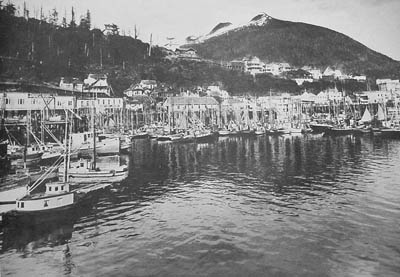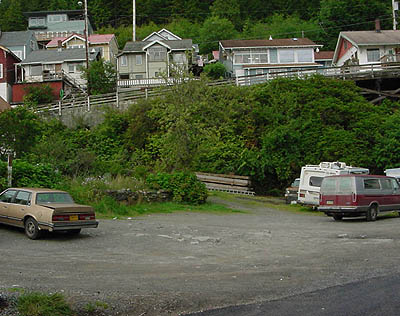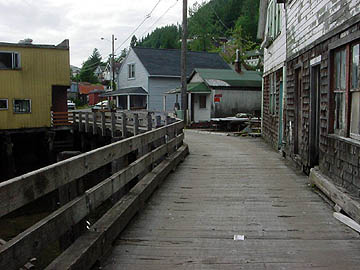 By June Allen August 12, 2002
In its earlier years the building had served as a city warehouse and truck repair facility. Ketchikan-born Wally Kubley, now retired in Edmonds, Wash., remembers that his family moved into a house on a still-forested hillside at 630 Water Street, just across the plank street from the even-then green-shingled city warehouse, when he was a small child. They moved to Newtown in 1924, Kubley recalls, because his mother refused to live any longer in the central downtown area after the terrible fire that destroyed the Revilla hotel - which was located on today's Ingersoll Hotel site. He confirms that the building was there in the mid-20s, although the date it was built is still a mystery. Oldtimer Bud Beck, who is very interested in the city's history, also remembers the old warehouse there when he was a boy. The warehouse/old civic center building itself had no particular claim to fame, unless you count the years that it served as the USO during World War II. The U.S. government, in the garb of the Coast Guard, took over the building to create a recreation and storage center. That was in the war-clouded fall of 1940, when the nation was preparing for defense in the event the U.S. was drawn into WWII. The CG Base, Annette Island, and other regional locations were welcoming increasing numbers of the military. The Pacific Coast from San Diego to the extensive shores of Alaska's Aleutians were prime targets for attack along the Pacific Rim - the Aleutians being a natural first stepping-stone for an enemy advance down the coast of North America to the 48 States. After the spacious Water Street property changed hands, a good deal of time was spent remodeling the building's interior into a USO, to provide an area for dancing and other events, for cooking and serving, and it boasted such added amenities as a soda fountain, a motion picture projector, soft drink cooler, a stove, and even cuspidors. A special quiet room was provided for GIs to write letters or read. Evelyn "Kappy" Kaplan was the facility's director. When all was organized, the ladies of the town volunteered to serve where needed and to dance with visiting personnel. Romances blossomed - note that Ketchikan's population rose significantly after the war with young marrieds. When the Water Street warehouse was vacated in 1940, the city's vehicles and crew were moved to the parkside Fair building, which itself had had a former life as a hatchery building in what is now City Park. Some of the townspeople were upset with the move, fearing to lose the Fair building where the annual autumn fair had been held since 1935 and where dances and other events were held during the rest of the year. But the City assured them that the vehicles could be stored out of the way when a fair was scheduled. But another fair was never held. Wartime was too near and Ketchikan was in an area too close to wartime events. Ketchikan in the 1940s was about to enter a period of rapid change, a change that would even accelerate in the following decade. In moving into the war years the country was also moving out of the economic slowdown of the Depression. Ketchikan was soon grow from a "town" to a "city." The technological advancements made during WWII would spur invention and creation of goods and products and ideas unthought of only a few years earlier. One light-hearted but memorable example: when GIs came home from the war in 1945-46, they would jump up more than ready to dance to radio music, not realizing what they were hearing might be an intro to one of radio's
Local innovations, too, were on the horizon. In 1946 the city built its first dog pound at the city dump. Two years later Ketchikan voted 432 against but 549 for a city manager form of government and L.M. McConnel was promoted from city clerk to city manager at the princely salary of $700 a month. And shortly after, the city bought parking meters - which required the city to hire a parking meter repairman at $325 a month in addition to the meters' initial costs! Two-way police radios were in the near future. Things were moving at a dizzying pace. It was in 1947 that the United States of America deeded the closed Water Street USO building and its amenities back to the City for $5,250. The facility was a natural for a community civic center and that's what it became. A group called the Ketchikan Recreational Council was formed to sponsor it. The proposed budget was estimated at $12-15,000 a year. The recreational council offered a one-year program proposal that included teenage dances, Junior Red Cross meetings as well as use for gatherings of civic organizations on a fee basis, and possibilities as a "little theater" - with a self-supporting canteen envisioned. The program was planned for volunteer management and oversight. The grand opening was held Sept. 20, 1947 - organized by the experienced USO director Evelyn "Kappy" Kaplan. She announced her plans in a Chronicle news story. "There will be a planned recreational program such as teenage dances, junior movies, hobby clubs, pingpong, badminton, basketball, photography, music and dance instruction, tumbling, boxing and other activities" - all supervised. The opening of the center was apparently supported by the public. The newspaper stated that 1,500 persons attended the grand opening! A following teen-age grand opening was held with a good turnout, the news reported. Over the following years the old Civic Center had its good years and its bad ones, probably depending on volunteer enthusiasm. When a new civic center volunteer group took over in the mid-1960s, a stash of shoe-roller skates was found, the battered conditions of the skates testifying to the fact that they had been well used on the spacious wooden floor of the center's second story. In the '60s, however, the major events were hootenannies, an adult arts and crafts exhibit that grew into an annual event, and teen dances. A fact still to be discovered for this story is in what year the big old green-shingled civic center building was erected on Water Street. There are, however, a few guesses, based on Newtown's general history. Why the name "Newtown" was chosen for that neighborhood along the short length of Water Street is a mystery in itself. New? Ketchikan was little more than a jury-rigged dock and a cluster of small, raw buildings in 1898 when newcomers snatched up waterfront parcels on the west side of Knob Hill, the rocky promontory that divided downtown from the "new" town. To get from one side to the other required either a boat or a trek over what came to be called Skyline trail over the hill, a trail with one terminus said to be on upper Front/Main and the other in today's parking lot behind Newtown's First City Saloon. Then in 1902 J.W. Young, a Newtown merchant, was elected to the city's Common Council. He was a respected gentleman who had arrived on the island in 1895 to become Saxman's first teacher. It may have been on his motion that the council passed an ordinance Nov. 5, 1902, to build a 10-foot wide "sidewalk" from the intersection at Front and Grant along the water and around the knob of rock to Newtown, for a total length of 1200 feet. Property owners along the way were assessed at the rate of 25 cents a foot. One R.C. Turner got the job on his low bid of $1210. That 'sidewalk," wide enough to accommodate a horse and dray wagon and still leave room for pedestrians opened Newtown's way to downtown's docks and services. It would be another half-century before today's tunnel was blasted through the rock. Newtown itself - and the old Civic Center was a product of Newtown's growth - is worthy of exploration today. Bud Beck says that for an understanding of early Newtown, a walk or slow drive through narrow Hopkins Alley gives a clue to what Newtown's waterfront was like early in the century. As a potentially successful business section, early Newtown was "challenged." He says to look carefully at the rear façade of the Water Street building that backs onto the alley. He says you'll see an "indented" entrance, typical of old commercial buildings, with windows on either side for light and display - the windows boarded up now, of course. That, he says, was the way Water Street faced way back when!
A history of Ketchikan's "city street expansion" would be a much-appreciated project to answer a great many questions about the city's growth! But until such a document is created, and since economic development is always the spur of infrastructure progress, it is safe to assume that the construction of a pioneer Tongass Trading Co. branch at the edge of Newtown in 1915 may have had an influence on the neighborhood's improvements. The Tongass Trading branch was just beyond today's Talbot's. A new street would continue west from that point under a new name - Tongass Avenue, named for the Tongass Trading branch store. By 1915, commercial fishing was entering its boom years! The floating fish trap invented in 1910 had revolutionized the salmon cannery industry The halibut fleets were already eyeing Ketchikan as a fleet base, after the announcement of the opening of transcontinental railroad at Prince Rupert. B.C. The first automobiles and a butcher's delivery motorcycle had made their appearance on the city's streets. The next year the Fire Department would buy its Ford Pumper Truck #1. The town was growing westward and would soon embrace the fishermen families in houses on stilts along the shore of the Narrows on what today is the West End. Maybe that period of activity is when the old city warehouse/Civic Center was built? Today's modern Civic Center atop Boston Smith Hill, dedicated in 1994, is named for favorite son and former Mayor Ted Ferry, who died just days before the ceremony in which the building named in his honor was dedicated. He was a lifelong resident of Newtown.
For information for this story, Thanks! to Karla Sunderland of the Museum, City Clerk Katie Suiter, Ed Anderson in Public Works, Wally Kubley, and especially to Bud Beck, who took time out of a busy day to meet web site publisher/photographer Dick Kauffman at Hopkins Alley to show him some of Newtown's points of interest.
|
||||


